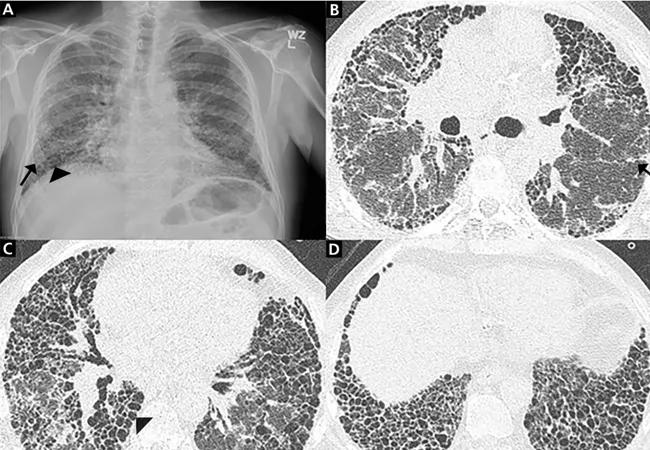Advertisement
An overview of IPF for primary care physicians

By Leslie B. Tolle, MD, Brian D. Southern, MD, and Daniel A. Culver, DO
Advertisement
Cleveland Clinic is a non-profit academic medical center. Advertising on our site helps support our mission. We do not endorse non-Cleveland Clinic products or services. Policy
Idiopathic pulmonary fibrosis (IPF) is a devastating and fatal lung disease that generally affects older adults. It is characterized by a radiographic and histopathologic pattern of usual interstitial pneumonia (UIP) that has no other known etiology.
Accurate diagnosis of IPF is crucial. We recommend early referral to a center specializing in interstitial lung disease to confirm the diagnosis, start appropriate therapy, advise the patient on prognosis and enrollment in disease registries and clinical trials and determine candidacy for lung transplant.
Primary care physicians are uniquely positioned to encounter patients with IPF, whether because of a patient complaint or as an incidental finding on computed tomography. The goal of this article is to delineate the features of IPF so that it may be recognized early and thus expedite referral to a center with expertise in interstitial lung disease for a thorough evaluation and appropriate management.
IPF is one of more than 150 interstitial lung diseases (ILDs), conditions that share nonspecific symptoms such as dyspnea and a dry cough with insidious onset, certain radiologic findings and a restrictive ventilatory defect. More specifically, IPF is categorized with the idiopathic interstitial pneumonias, which include idiopathic nonspecific interstitial pneumonia, respiratory bronchiolitis-associated interstitial lung disease, diffuse alveolar hemorrhage, cryptogenic organizing pneumonia and acute interstitial pneumonia. Identification of the pattern of UIP, the hallmark of IPF, is integral to establishing the diagnosis, as is exclusion of other causes of ILD — e.g., connective tissue disease, medication reaction, inhalational exposure, pneumoconioses and granulomatous diseases (both infectious and noninfectious).
Advertisement
The true incidence and prevalence of IPF are difficult to assess. IPF is generally considered a rare disease, but it is more common than once thought. In 2011, Raghu et al estimated the prevalence in Medicare beneficiaries to be 495 cases per 100,000. Based on this estimate and the current US population, up to 160,000 Americans could have IPF. Raghu et al also showed that IPF more often affects adults over age 65, which suggests that as the US population ages, the incidence of IPF may rise. Studies have also reported an increased incidence of IPF worldwide.
IPF is typically progressive and limited to the lungs, and it portends a poor prognosis. The median survival is commonly cited as two to five years from diagnosis, although this is based on older observations that may not reflect current best practice and newer therapies.
As the name indicates, the etiology of IPF is unknown, but studies have indicated genetic underpinnings in a notable proportion of cases. Regardless of the cause, the pathogenesis and progression of IPF are thought to be the result of an abnormal and persistent wound-repair response. The progressive deposition of scar tissue disrupts normal lung architecture and function, eventually causing clinical disease.
Patients with IPF typically present with the insidious onset of dyspnea on exertion, with or without chronic cough. Risk factors include male sex, increasing age and a history of smoking. Patients with undiagnosed IPF who present with dyspnea and a history of smoking are often treated empirically for chronic obstructive pulmonary disease (COPD).
Advertisement
Rales are a common finding on auscultation in IPF, and this can lead to an exhaustive cardiac evaluation and empiric treatment for heart failure. Digital clubbing is also relatively common. Hypoxemia with exertion is another common feature that also often correlates with disease severity and prognosis. Resting hypoxemia is more common in advanced disease.
On spirometry, patients with IPF typically demonstrate restrictive physiology, suggested by a normal or elevated ratio of the forced expiratory volume in one second to the forced vital capacity (FEV 1/FVC) (> 70 percent predicted or above the lower limit of normal) combined with a lower than normal FVC. Restrictive physiology is definitively demonstrated by a decreased total lung capacity (< 80 percent predicted or below the lower limit of normal) on plethysmography. Impaired gas exchange, manifested by a decreased diffusing capacity of the lungs for carbon monoxide (DLCO) on pulmonary function testing, is also common. Because pulmonary perfusion is higher in the lung bases, where IPF is also predominant, the DLCO is often reduced to a greater extent than the FVC.
Clinicians typically view IPF as a relentless and progressive process, but its course is variable and can be uncertain in an individual patient. Nevertheless, over time, most patients have a decline in lung function leading to respiratory failure. Respiratory failure, often preceded by a subacute deterioration (over weeks to months) or an acute deterioration (< four weeks), is the most common cause of death, but comorbid diseases such as lung cancer, infection and heart failure are also common causes of death in these patients.
Predictors of mortality include worsening FVC, DLCO, symptoms and physiologic impairment, manifested by a decline in the six-minute walking test or worsening exertional hypoxemia. Other common comorbidities linked with impaired quality of life and poor prognosis include obstructive sleep apnea, gastroesophageal reflux disease and depression. Retrospective studies suggest that most IPF patients die two to five years after symptom onset. With the lag from symptom onset to final diagnosis, the average life expectancy is as little as two years from the time of diagnosis.
Advertisement
Two staging systems have been developed to predict short-term and long-term mortality risk based on sex, age and physiologic parameters. The GAP (gender, age, physiology) index provides an estimate of the risk of death for a cohort of patients: a score of 0 to 8 is calculated, and the score is then categorized as stage I, II, or III. Each stage is associated with one-, two- and three-year mortality rates, with stage III having the highest rates. The GAP calculator provides an estimate of the risk of death for an individual patient. The application of these tools for the management of IPF is evolving; however, they may be helpful for counseling patients about disease prognosis.
Drs. Tolle and Southern are staff in the Respiratory Institute. Dr. Culver is Director of the Interstitial Lung Disease Program.
This abridged article and the feature image originally appeared in Cleveland Clinic Journal of Medicine.
Image: Radiographic patterns of definite usual interstitial pneumonia. Chest radiography (A) shows mildly decreased lung volumes with basilar-predominant coarse reticular (linear) opacities (arrow) and intervening areas of cystic lucencies, consistent with honeycombing (arrowhead). Axial high-resolution computed tomography (B, C, and D) shows coarse subpleural reticulation (arrow in B), traction bronchiectasis, and severe honeycombing, ie, rows of cysts stacked one on top of the other (arrowheads in C and D). These progressively worsen as the images move inferiorly.
Advertisement
Advertisement

An updated review of risk factors, management and treatment considerations

OMT may be right for some with Graves’ eye disease

Perserverance may depend on several specifics, including medication type, insurance coverage and medium-term weight loss

Integrate climate-related health information and counseling into your practice

Physicians discuss a specific case example, and PICC pros, cons and alternatives

A snapshot of the 2020 GINA report

A review of available interventions

Abstinence from combustibles, dependence on vaping